Wood, aluminum, or carbon? What broadhead? How about draw weight? Over time, traditionalists will face a long list of choices, some to be decided quickly and others never at all. Beginners will have plenty of time to consider them as they consult books and videos, argue (politely) with friends, listen to veterans, and acquire experience of their own. One important choice, however, comes right from the moment you decide to pursue the challenging life of a traditional shooter. Do I want to shoot a longbow or a recurve?
However you decide at first, remember that your decision is not irrevocable. You may go back and forth as I have. While I’ll refer to some of my own experience in the following text as means of illustrating certain principles, I’m not trying to influence anyone one way or the other. The choice is yours alone.
I would first like to address the common misconception that longbows are somehow more traditional than recurves. Granted, the earliest bows to appear in the archeological record were basically straight sticks. Otherwise, they had little in common with what we think of as longbows today, which largely evolved in Europe during the early medieval era. By that time, Asiatic horse archers invading from the East had learned that reducing the overall length of a bow by curving it did not compromise performance and certainly made it easier to shoot while riding a horse. A careful reading of the Iliad and the Odyssey convinced me that Homeric Era bows were curved (although it’s hard to tell exactly how), and the Trojan War took place over 1,000 years BCE. So, both styles have plenty of tradition behind them, and beyond that, who cares?
Next, we need to define our terms, as the distinction between longbows and recurves can become blurry. Here’s the simple version. If the string travels straight from the nock on one limb to the nock on the other end without touching limb faces, it’s a longbow. If the limb tips curve so that the string contacts the limbs beyond the nocks, it’s a recurve. Confusion arises regarding the newer “hybrid” style, which looks like a longbow at first but has some deflex-reflex in its limb design. Since the string contacts the limb faces, if only slightly, these bows do not meet the previous definition of a longbow, but they don’t look like most recurves either. My solution is to call them hybrids and not worry further.
Now, let’s cut to the chase and examine advantages and disadvantages of each major traditional bow style. Many of these observations are personal and subjective, and the novice should not regard all of them as set in stone.
Recurves
Advantages:
- Shorter overall length makes them easier to maneuver in tight spots such as blinds and tree stands, or when stalking through grass or brush.
- Thick grip contour makes bow easier to hold securely during draw and release and may make the transition from a compound easier.
- Slight let-off at full draw makes it a bit easier to hold at full draw and may also help the transition from a compound.
- Three-piece takedown models feel and shoot almost identically to their single piece counterparts.
- Take-down ability is a big advantage when traveling, by anything from commercial aircraft to horseback.
- Usually (but not always) recurves tolerate differences in arrow spine better than longbows.
- Many (but not all) experienced archers consider them easier to shoot and intrinsically more accurate.
Disadvantages:
- Easier to twist a limb.
- A bit harder to string without a stringer.
- Tendency to pick up brush or other debris between the string and limb tip. (Easily addressed with “brush buttons.”)
- Heavier, of some significance on long backpack trips, when hunting steep terrain, or during weight-sensitive bush flights.
- According to some, less “feel” for the arrow and its flight. (Longbow master Howard Hill once said he wasn’t “good enough” to shoot a recurve.)
- Lacks the longbow’s intangible element of “romance” and role in modern European history. (Longbows were crucial to British victory in the battles of Crecy and Agincourt.)
- More string noise when shot, especially if not properly tuned.
- Higher cost (in some cases).
Longbows
Advantages:
- Light weight, easy to carry.
- Don’t pick up brush between string and limb tip.
- Easy to string, less susceptible to limb twist.
- Quieter when shot.
- Provides more intimate “feel” between bow hand, grip, and arrow.
- May be less expensive than comparable quality recurve.
- Just plain sexy.
Disadvantages:
- Harder to maneuver in tight places.
- More susceptible to limb interference by obstructions.
- Requires more time to master a perfect grip.
- Greater tendency to “stack” (see definition below).
- One-piece structure makes transportation more difficult.
Since I promised a brief definition of stack, here we go. The term applies to the mathematical relationship between length of draw (which always increases during shooting), and the force required to maintain it (draw weight at any given draw length). If you connect the dots on a graph with draw length on the horizontal axis and draw weight on the vertical, a hypothetical bow with no stack at all will produce a straight line. If the line rises sharply as you approach shooting draw length, the bow is stacking (as almost all bows do, at least to some degree).
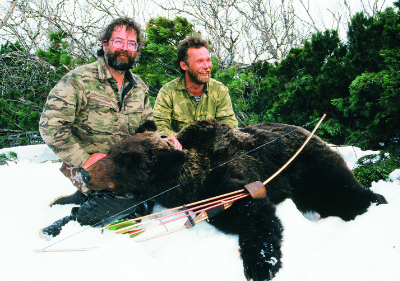
A 72# longbow did just fine on this Russian brown bear. The hassle of hauling it around the world eventually aroused my interest in takedown recurves.
Greater stacking compromises a smooth draw and makes it more difficult hold at full draw. However, stack isn’t all bad. Many experienced longbow shooters subconsciously use that increase in string tension as a cue to shoot, much like a clicker. Although I can’t prove it, I think this factor makes target panic rarer among longbow shooters.
Now I’ll illustrate some of these points by reviewing how my own choices have evolved over decades. These choices were purely personal, and I don’t present them as right answers for others. They just provide one example of how factors outlined above influence the decision-making process.
My first “real” bow (in other words, one I hadn’t made myself from a whittled sapling and baling twine) was a longbow according to the earlier definition. A green glass Ben Pearson—the same bow with which many of my generation’s shooters began—drew about 25 pounds. In retrospect, it proved remarkably accurate in hunting situations, which at that time consisted of shooting frogs—which I made my mother cook—and field mice running across the floor of our horse barn. (How one can hit a running mouse and miss a standing deer remains a mystery.)
Distracted by shotguns and fly rods, I didn’t upgrade until I moved to Montana in 1973. The target-rich environment and generous bow season ignited my interest in bowhunting big game. Although I had grown up in a hunting family, no one hunted with a bow. Since bowhunting was not as popular then as it is now, I didn’t have a mentor as many novices do today. I realized that I needed a real hunting bow, and absent any guidance, I picked up a Herter’s catalog (another standby in those days), looked at pictures of Steve Gore with bow-killed animals, and bought a 50# one-piece recurve of uncertain provenance. The next several seasons taught me that I shot well enough to bring home some rabbits and grouse, but that killing big game with a bow was a lot harder than I thought. For sentimental reasons, I wish I still had that bow, but I lent it to some beginner and never saw it again. A slow learner, I’ve done that with several bows since and never really regretted it.
The next phase in my development came when I moved to our current Montana hometown and met an accomplished local bowhunter. He became my first mentor, and since he shot modern tackle my brief trip to the dark side was likely inevitable. I killed a few deer with a compound during the next two seasons, but never felt comfortable about it. We had a very active local bowhunting club for such a small town and one of the best ranges in the state, but I never saw more than one or two traditional shooters there.
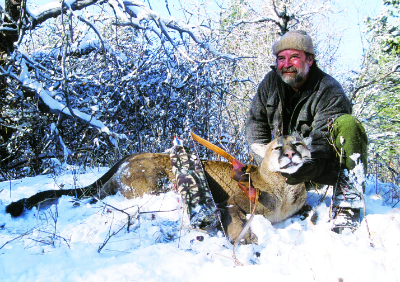
This tom fell at the end of an all-day chase. Carrying a broken-down recurve in my pack made backcountry hiking easier.
Everything changed when I met my new neighbor, Dick Robertson. He soon had one of his longbows in my hands. I have never shot better than I did with that bow, probably because I loved it so much that I literally shot it every day. I began killing animals with it. Consistently winning at shoots boosted my confidence. Other club members began asking me about shooting longbows, and I introduced several of them to traditional tackle. That’s how I went from needing a mentor I couldn’t find to becoming one myself.
When I moved to Alaska in 1980, that longbow went with me and I used it successfully on new to me big game animals, especially caribou and bears. There followed an annual series of DIY sheep hunts during which I never managed a shot. I took that longbow with me on an exploratory trip to the Soviet Far East, where I killed a brown bear with it. That trip began an extended period of international bowhunting, which changed my perspective once again.
Simply stated, long distance travel with a longbow was a hassle. The airlines never managed to lose it, but they sure tried. Examining the homemade PVC tube I carried it in made it apparent that if they couldn’t lose it, they were trying to beat it to death. Before I knew it, I was shooting and traveling with a three-piece takedown recurve, also from Dick Robertson.
With heavy clothing to pad the bow (I frequently packed the limbs inside hip waders) and arrows in another homemade tube, I could pack everything I needed for an extended trip, including a camera tripod and fly rod, in one Cabela’s duffel bag. I acquired more recurves from Dick, gradually increasing my draw from 60# to 72# (a mistake, as my right shoulder eventually informed me). Unlike some archers, I didn’t have trouble going back and forth between longbow and recurve. I never shot any of those recurves as well as I shot my old longbow.
Next, I tried splitting the difference with three-piece takedown hybrids that proved to be neither fish nor fowl. They were easy to transport, but I never shot them as well as my other bows. While their solid handles and shorter limbs looked good on paper, they never evoked the ultralight feel of my longbows. I stopped shooting hybrids. Following shoulder surgery, I began donating my heavier bows to auctions at bowhunting banquets.
I’m still shooting and hunting, with a 48# Robertson recurve. My journey up and down the draw-weight scale may prove instructive. I started out with a 62# longbow and advanced easily to the low 70#s as I began to hunt elk, moose, and bears. I bought a 58# recurve at a PBS auction and wondered what I was going to hunt with such a light bow. (Answer: turkeys and antelope.) Prior to several seasons with Asiatic buffalo in Australia, I worked up to 85# (with effort) only to realize I didn’t need it.
Then came the shoulder injury. Even after a year of physical therapy, I couldn’t shoot anything. Anxious not to miss another deer season, I commissioned the 48# recurve I’m shooting today. I’m also trying to advance (slowly) to a 55# recurve in hopes of more elk hunting. While much of the difficulty I’m experiencing now results directly from the rotator cuff failure in my drawing arm, a lot is also due to simple deconditioning and loss of muscle memory, which I’m working on regularly with weights.
The takeaway is that you can expect your comfortable draw weight to change over time, and you should anticipate acquiring new bows to address these changes. The switch from compound to traditional will require changes in form that will likely make your trad bow feel “heavier” even at the same draw weight as your compound. To avoid the bad form habits that shooting too much bow can cause, I recommend that a first trad bow be at least 5-10 pounds lighter than your compound. You can always advance as your body adapts to new shooting form.
What final advice can I offer newcomers? Your initial decision regarding longbow or recurve doesn’t have to be permanent. Consider your first bow a starter, and don’t invest too much money in it as you will likely either outgrow it or change your mind about what works best for you. Whatever your choice of style, don’t over-bow yourself at first, which will lead to bad shooting habits. Heavier poundage will come with time and experience. Go to the range with friends and shoot several bows before you buy your first one.
No matter what you choose, commit to sticking with the process. If you can do that, a grand adventure awaits.
Former Co-editor Don Thomas and his wife Lori live in central Montana with their hunting dogs. While retirement has given them more time to travel, hunt, and fish, they miss regular contact with all who worked with them at the magazine. They still enjoy contributing to TBM.


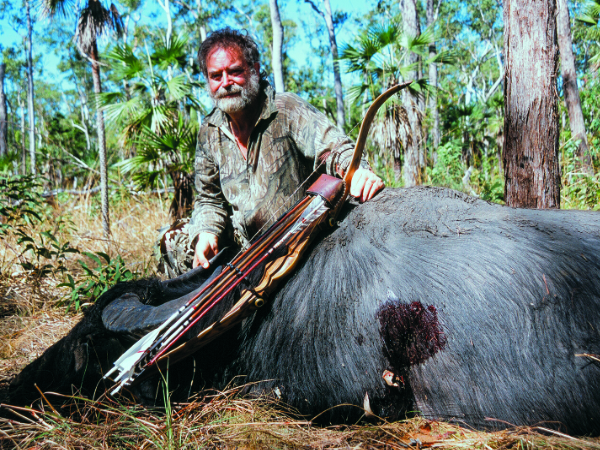
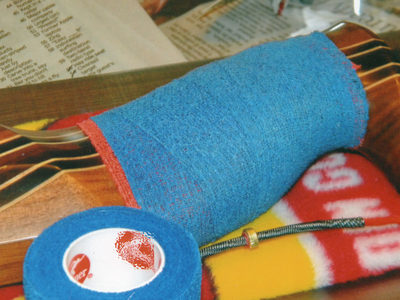
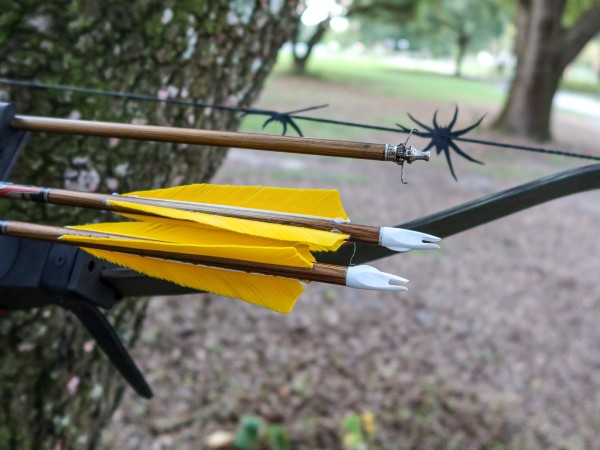


Outstanding explanation on longbows and recurves. I’ve shot both for years and enjoy making my own two-piece takedown longbows.
My biggest concern is and always has been with broadhead styles and designs. While the original Howard Hill broadhead did everything one could ask for, many broadheads today do not “cut it”! They are too noisy and flirt too much when shot out of either a recurve or longbow. Too bad bowhunters can’t use original Hill style heads today. It would solve a lot of performance issues.